In the delicate dance of cannabis cultivation, pest management stands as a pivotal challenge. Chemical interventions pose risks to both crop and environment, urging a shift towards sustainable solutions. Enter beneficial bugs and insects—the unsung heroes of pest control in cannabis grows. From the voracious appetite of ladybugs to the cunning tactics of assassin bugs, nature offers a diverse arsenal against common pests like aphids, mites, and fungus gnats. In this guide, we explore the world of beneficial insects, uncovering their roles and effectiveness in safeguarding cannabis crops while preserving the integrity of the final product. Welcome to the intersection of science and sustainability, where the smallest allies yield the greatest results.
Table of Contents
Understanding Pest Management in Cannabis Cultivation
Beneficial Bugs and Insects in Cannabis Cultivation
3. Predatory Mites (Phytoseiulus persimilis)
6. Praying Mantises (Mantodea)
8. Rove Beetles (Staphylinidae)
Choosing the Right Beneficial Insects for Your Cannabis Garden
Tips for using Beneficial Bugs into Your Cannabis Grow
Potential Challenges and Risks
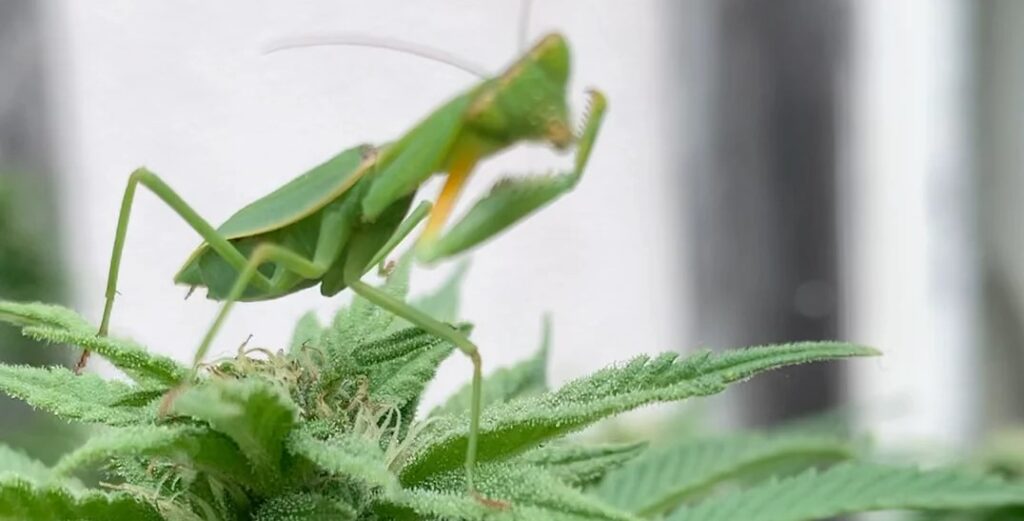
Understanding Pest Management in Cannabis Cultivation
Pests are a perennial challenge in cannabis cultivation, capable of wreaking havoc on yields and quality if left unchecked. This section provides an overview of the common pests that afflict cannabis plants, along with the importance of adopting integrated pest management (IPM) strategies to combat them effectively.
Overview of Common Pests:
Cannabis plants are susceptible to a variety of pests throughout their lifecycle. Among the most prevalent are aphids, tiny insects that pierce plant tissues and sap vital nutrients. Spider mites, another notorious pest, thrive in warm and dry conditions, spinning webs and sucking the life out of leaves. Fungus gnats, with their larvae residing in moist soil, pose a threat to root health and nutrient uptake. These are just a few examples of the pests that cannabis growers contend with, each presenting its own set of challenges and potential damage to the crop.
Importance of Integrated Pest Management (IPM) Strategies:
In the battle against pests, a multifaceted approach is key to success. Integrated pest management (IPM) combines various tactics to minimize pest populations while minimizing harm to the environment and human health. Unlike conventional pesticide applications, which can lead to pesticide resistance and environmental pollution, IPM emphasizes prevention, cultural practices, biological controls, and targeted interventions. By integrating techniques such as crop rotation, sanitation, beneficial insect release, and habitat manipulation, growers can create a balanced ecosystem where pests are kept in check naturally. This holistic approach not only mitigates pest damage but also fosters long-term sustainability and resilience in cannabis cultivation.
Beneficial Bugs and Insects in Cannabis Cultivation
Beneficial bugs and insects play a vital role in maintaining a balanced ecosystem within cannabis cultivation environments. This section provides an in-depth exploration of these natural predators and their indispensable contributions to pest control.
Explanation of Beneficial Insects and Bugs:
Beneficial insects and bugs are organisms that prey on or parasitize pest species, helping to regulate their populations naturally. These beneficial organisms can be broadly categorized into predators, parasites, and pollinators. Predators such as ladybugs, lacewings, and assassin bugs actively hunt and consume pest insects, while parasites like parasitic wasps lay their eggs inside pest hosts, ultimately leading to their demise. Pollinators, such as bees and hoverflies, aid in the pollination of cannabis flowers, ensuring successful reproduction and seed development. Together, these beneficial bugs form an integral part of the ecosystem, contributing to pest suppression and overall plant health.
Role in Pest Control:
Beneficial bugs and insects serve as nature’s pest control agents, offering a sustainable and eco-friendly alternative to chemical pesticides. Ladybugs, for example, are voracious predators of aphids, mites, and other soft-bodied pests, while lacewings devour aphids, thrips, and mites with equal gusto. Assassin bugs are adept ambush predators, targeting a wide range of pests including caterpillars, beetles, and leafhoppers. By introducing and maintaining populations of these beneficial insects in cannabis cultivation environments, growers can effectively manage pest outbreaks while minimizing environmental impact and preserving the quality of their crops.
| Beneficial Bugs | Target Pest |
|---|---|
| Ladybugs | Aphids, mites, thrips, whiteflies |
| Lacewings | Aphids, thrips, mites |
| Predatory Mites | Spider mites |
| Assassin Bugs | Aphids, caterpillars, beetles, leafhoppers |
| Hoverflies | Aphids, thrips, mealybugs |
| Praying Mantises | Aphids, caterpillars, beetles, flies, moths |
| Predatory Nematodes | Fungus gnats, root aphids |
| Rove Beetles | Fungus gnats |
1. Ladybugs (Coccinellidae)
Ladybugs, with their vibrant appearance and voracious appetite, are among the most iconic and effective predators in the realm of pest control. This section provides a detailed look at these beneficial insects, their role in controlling common pests like aphids and mites, and strategies for attracting and releasing them in cannabis cultivation environments.

Ladybugs as a Predator:
Ladybugs, also known as lady beetles or ladybird beetles, belong to the family Coccinellidae and are characterized by their distinctive round shape and brightly colored elytra, or wing covers. These beneficial insects are voracious predators, with both larvae and adults feeding on a variety of soft-bodied pests, including aphids, mites, scale insects, and thrips. Ladybugs are highly adaptable and can thrive in diverse habitats, making them valuable allies in the fight against pests in cannabis cultivation.
Effectiveness in Controlling Pests:
Ladybugs are particularly effective at controlling aphid populations, which can rapidly infest cannabis plants and sap their vitality. Both adult ladybugs and their larvae feed on aphids, consuming large numbers of these pests and preventing them from causing further damage to the crop. Additionally, ladybugs are known to prey on other common pests such as spider mites, mealybugs, and whiteflies, making them versatile and invaluable assets in pest management strategies.
How to Attract and Release Ladybugs:
Attracting and releasing ladybugs into a cannabis grow can be an effective way to establish a resident population of these beneficial insects. One method is to provide suitable habitat and food sources for ladybugs, such as flowering plants that produce pollen and nectar. Additionally, commercial suppliers offer live ladybug larvae or adults for purchase, which can be released directly onto cannabis plants experiencing pest infestations. It’s important to release ladybugs during the cooler hours of the evening or early morning and to avoid the use of chemical pesticides that may harm these beneficial insects.
2. Lacewings (Chrysopidae)
Lacewings, with their delicate appearance and voracious appetite for pests, are invaluable allies in the realm of natural pest control. This section provides an overview of lacewings, their role in controlling common cannabis pests like aphids, thrips, and mites, and techniques for attracting these beneficial insects to cannabis gardens.
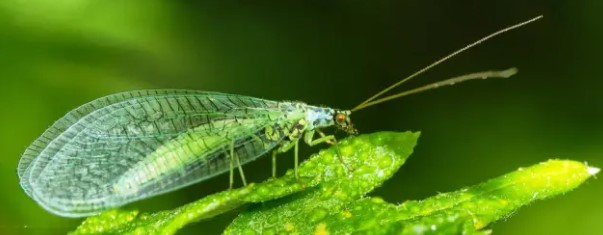
Lacewings:
Lacewings belong to the family Chrysopidae and are characterized by their delicate, green or brownish bodies and intricate lacy wings. These graceful insects are voracious predators in both their larval and adult stages, feeding on a wide range of pests including aphids, thrips, mites, and small caterpillars. Lacewing larvae, often referred to as “aphid lions,” are particularly adept at hunting and consuming aphids, making them valuable assets in the fight against these destructive pests in cannabis cultivation.
Role in Controlling Pests:
Lacewings play a crucial role in controlling common cannabis pests, including aphids, thrips, and mites, by preying on their populations and preventing infestations from spiraling out of control. Lacewing larvae are especially effective at consuming large numbers of aphids, piercing them with their sharp mandibles and sucking out their bodily fluids. Additionally, lacewings are known to feed on thrips and mites, helping to keep their numbers in check and protecting cannabis plants from damage.
Methods for Attracting Lacewings:
Attracting lacewings to a cannabis garden can be accomplished through various methods that provide suitable habitat and food sources for these beneficial insects. Planting a diverse array of flowering plants, such as yarrow, dill, and fennel, can provide lacewings with pollen and nectar, while also attracting other beneficial insects. Additionally, lacewing larvae can be purchased from commercial suppliers and released directly onto cannabis plants experiencing pest infestations. It’s essential to avoid the use of chemical pesticides that may harm lacewings and other beneficial insects while implementing these attraction methods.
3. Predatory Mites (Phytoseiulus persimilis)
Predatory mites, specifically Phytoseiulus persimilis, are microscopic warriors in the battle against spider mites, providing an effective and natural solution for controlling these troublesome pests in cannabis cultivation. This section provides a description of predatory mites, their effectiveness against spider mites, and tips for introducing them into a cannabis grow environment.
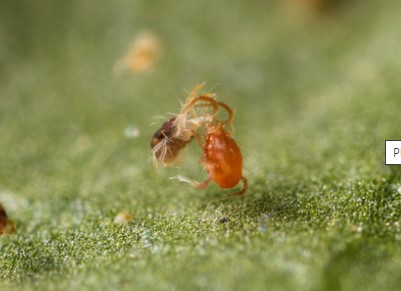
Predatory Mites:
Predatory mites, including Phytoseiulus persimilis, are tiny arthropods that belong to the family Phytoseiidae. These voracious predators are specialized in feeding on spider mites, which are notorious for infesting cannabis plants and causing significant damage. Predatory mites are highly adaptable and reproduce rapidly under favorable conditions, making them an excellent biological control agent against spider mites in cannabis cultivation.
Effectiveness Against Spider Mites:
Predatory mites, particularly Phytoseiulus persimilis, are highly effective at controlling spider mite infestations in cannabis grows. These beneficial mites actively hunt and feed on all life stages of spider mites, including eggs, nymphs, and adults, effectively suppressing their populations and preventing further damage to the plants. Unlike chemical pesticides, which can lead to resistance and environmental contamination, predatory mites offer a sustainable and eco-friendly solution for managing spider mite infestations in cannabis cultivation.
Tips for Introducing Predatory Mites:
Introducing predatory mites into a cannabis grow environment requires careful consideration and planning to ensure their successful establishment and efficacy in controlling spider mites. One common method is to purchase predatory mites from reputable suppliers and release them directly onto affected cannabis plants at the first sign of spider mite infestation. It’s essential to provide suitable environmental conditions, such as moderate temperatures and humidity levels, to promote the reproduction and activity of predatory mites. Additionally, avoiding the use of broad-spectrum pesticides that may harm predatory mites is crucial for their long-term effectiveness in controlling spider mites.
4. Assassin Bugs (Reduviidae)
Assassin bugs, members of the family Reduviidae, are formidable predators renowned for their stealthy hunting tactics and voracious appetite for a wide range of pests. This section provides an explanation of assassin bugs, their predatory behavior towards various pests, and considerations for introducing them into a cannabis garden.
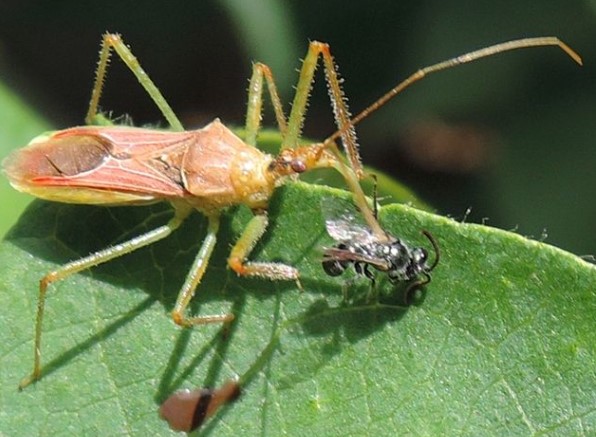
Assassin Bugs:
Assassin bugs are a diverse group of predatory insects belonging to the family Reduviidae, characterized by their elongated bodies and powerful piercing-sucking mouthparts. These stealthy hunters are adept at ambushing their prey, using their sharp beak to inject toxic saliva and liquefy the internal tissues of their victims. Assassin bugs exhibit a wide range of hunting strategies, from patiently stalking their prey to actively pursuing and capturing it, making them highly effective predators in diverse environments.
Predatory Behavior Towards Various Pests:
Assassin bugs are versatile predators capable of preying on a variety of pests that commonly afflict cannabis plants. Their diet includes aphids, caterpillars, beetles, leafhoppers, and other soft-bodied insects, making them valuable allies in the battle against pest infestations in cannabis cultivation. Assassin bugs use their stealth and agility to ambush unsuspecting prey, delivering a lethal bite and consuming the liquefied contents of their victims. Their predatory behavior helps to keep pest populations in check and prevent damage to cannabis plants, contributing to overall plant health and vigor.
Considerations for Introducing Assassin Bugs:
Introducing assassin bugs into a cannabis garden requires careful consideration to ensure their successful establishment and effectiveness in controlling pest populations. One method is to attract assassin bugs naturally by providing suitable habitat and food sources, such as flowering plants that produce pollen and nectar to sustain adult assassin bugs. Additionally, commercial suppliers offer assassin bug nymphs or adults for purchase, which can be released directly onto cannabis plants experiencing pest infestations. It’s essential to monitor assassin bug populations closely and avoid the use of chemical pesticides that may harm these beneficial insects, allowing them to thrive and fulfill their role as natural pest controllers in the cannabis garden.
5. Hoverflies (Syrphidae)
Hoverflies, members of the family Syrphidae, are valuable allies in cannabis cultivation due to their role as natural predators of aphids and other soft-bodied insects. This section provides an overview of hoverflies, their effectiveness in controlling aphids and other pests, and techniques for attracting them to a cannabis grow.

Hoverflies:
Hoverflies, also known as flower flies or syrphid flies, are members of the family Syrphidae and are characterized by their striking resemblance to bees and wasps. Despite their mimicry, hoverflies are harmless to humans and plants, with adults primarily feeding on nectar and pollen from flowers. However, hoverfly larvae are voracious predators of aphids, mealybugs, thrips, and other soft-bodied insects, making them valuable natural enemies of common pests in cannabis cultivation.
Effectiveness in Controlling Pests:
Hoverflies play a crucial role in controlling aphid populations in cannabis cultivation by preying on their eggs, nymphs, and adults. Hoverfly larvae, commonly referred to as “aphid lions,” actively hunt and consume aphids, piercing them with their sharp mouthparts and sucking out their bodily fluids. Additionally, hoverflies are known to feed on other soft-bodied pests, including mealybugs and thrips, providing further protection to cannabis plants against pest infestations. Their effectiveness in controlling pests makes hoverflies an invaluable asset in integrated pest management strategies for cannabis cultivation.
Techniques for Attracting Hoverflies:
Attracting hoverflies to a cannabis grow can be achieved through various techniques that provide suitable habitat and food sources for these beneficial insects. Planting a diverse array of flowering plants, such as marigolds, yarrow, and alyssum, can attract hoverflies by providing them with pollen and nectar. Additionally, avoiding the use of broad-spectrum pesticides that may harm hoverflies and other beneficial bugs is essential for their successful attraction and establishment in the cannabis garden. Creating a welcoming environment for hoverflies ensures a natural and sustainable approach to pest control in cannabis cultivation.
6. Praying Mantises (Mantodea)
Praying mantises, with their unique appearance and voracious appetite, are formidable predators capable of controlling a wide range of pests in cannabis cultivation environments. This section provides a description of praying mantises, their predatory nature towards various pests, and considerations for introducing them into a cannabis cultivation environment.
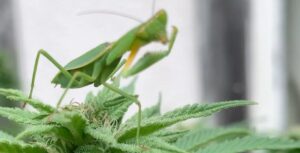
Praying Mantises:
Praying mantises belong to the order Mantodea and are characterized by their elongated bodies, triangular heads, and powerful forelegs adapted for grasping prey. These fascinating insects are skilled hunters, employing stealth and patience to ambush and capture their victims. Praying mantises are opportunistic feeders and will prey on a wide range of insects, including aphids, caterpillars, beetles, flies, and moths, making them versatile and effective natural enemies of pests in cannabis cultivation.
Predatory Nature Towards a Wide Range of Pests:
Praying mantises are renowned for their predatory prowess and voracious appetite for a wide range of pests that commonly afflict cannabis plants. Their agile and stealthy hunting tactics allow them to capture and consume aphids, caterpillars, beetles, and other pests with remarkable efficiency. Praying mantises are particularly adept at controlling flying insects such as flies and moths, snatching them out of the air with lightning-fast reflexes. Their predatory nature makes praying mantises invaluable allies in the fight against pest infestations in cannabis cultivation.
Considerations for Introducing Praying Mantises:
Introducing praying mantises into a cannabis cultivation environment requires careful consideration to ensure their successful establishment and effectiveness in controlling pest populations. One method is to purchase praying mantis egg cases, known as oothecae, from reputable suppliers and place them strategically throughout the garden. Upon hatching, the young mantises will disperse and begin hunting pests. It’s essential to provide suitable habitat, such as dense vegetation and sheltered areas, to support praying mantis populations and encourage their presence in the garden. Additionally, avoiding the use of broad-spectrum pesticides that may harm praying mantises and other beneficial insects is crucial for their long-term effectiveness in controlling pest infestations.
7. Predatory Nematodes
Predatory nematodes offer a unique and effective solution for controlling soil-dwelling pests such as fungus gnats and root aphids in cannabis cultivation. This section provides an explanation of predatory nematodes, their effectiveness against soil-dwelling pests, and methods for introducing them into a cannabis grow medium.
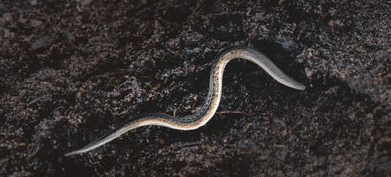
Explanation of Predatory Nematodes:
Predatory nematodes are microscopic roundworms that inhabit the soil and prey on other soil-dwelling organisms, including pest species such as fungus gnats and root aphids. Unlike plant-parasitic nematodes, which feed on plant roots and cause damage, predatory nematodes actively hunt and consume pest larvae, effectively suppressing their populations and preventing damage to cannabis plants. Predatory nematodes are a natural and environmentally friendly alternative to chemical pesticides for controlling soil-borne pests in cannabis cultivation.
Effectiveness Against Soil-Dwelling Pests:
Predatory nematodes are highly effective at controlling soil-dwelling pests such as fungus gnats and root aphids by targeting their larvae and preventing them from causing damage to cannabis plants. These beneficial roundworms actively seek out pest larvae in the soil, penetrating their bodies and releasing bacteria that kill them from within. Predatory nematodes reproduce rapidly under favorable conditions, forming a self-sustaining population that continues to control pest populations over time. Their effectiveness against soil-dwelling pests makes predatory nematodes an invaluable asset in integrated pest management strategies for cannabis cultivation.
Methods for Introducing Predatory Nematodes into a Cannabis Grow Medium:
Introducing predatory nematodes into a cannabis grow medium requires careful consideration to ensure their successful establishment and efficacy in controlling pest populations. One method is to purchase commercially available predatory nematode products, which come in a suspension that can be mixed with water and applied to the soil. It’s essential to follow the manufacturer’s instructions for application rates and timing to achieve optimal results. Additionally, providing suitable environmental conditions, such as adequate moisture and temperature, is crucial for the survival and activity of predatory nematodes in the grow medium. By incorporating predatory nematodes into the cannabis cultivation environment, growers can effectively manage soil-dwelling pest infestations while minimizing environmental impact and preserving plant health.
8. Rove Beetles (Staphylinidae)
Rove beetles, members of the family Staphylinidae, are unsung heroes in the realm of pest control, particularly for their effectiveness in controlling fungus gnats in cannabis cultivation environments. This section provides an introduction to rove beetles, their predatory behavior towards fungus gnats, and techniques for attracting and maintaining rove beetle populations in the cultivation environment.
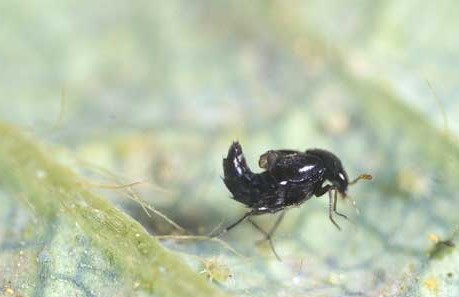
Introduction to Rove Beetles: Rove beetles are a diverse group of insects belonging to the family Staphylinidae, characterized by their elongated bodies, short wing covers, and distinctive habit of raising their abdomens in the air. Despite their unassuming appearance, rove beetles are formidable predators, with a voracious appetite for a variety of pests, including fungus gnats. Their predatory behavior makes them valuable allies in integrated pest management strategies for cannabis cultivation.
Predatory Behavior Towards Fungus Gnats: Rove beetles are particularly effective at controlling fungus gnat populations in cannabis cultivation environments by preying on their eggs, larvae, and pupae. Adult rove beetles actively hunt for fungus gnat larvae in the soil, where these pests typically reside, and consume them with gusto. Additionally, rove beetle larvae are also predatory and will feed on fungus gnat larvae and other small insects in the soil, further suppressing pest populations. By targeting multiple life stages of fungus gnats, rove beetles provide comprehensive and long-lasting control of these pests in cannabis grows.
Techniques for Attracting and Maintaining Rove Beetle Populations: Attracting and maintaining rove beetle populations in a cannabis cultivation environment can be achieved through various techniques that provide suitable habitat and food sources for these beneficial insects. Rove beetles are attracted to organic matter and decaying plant material, so maintaining a healthy layer of mulch or compost in the growing medium can help attract them to the garden. Additionally, providing sheltered areas such as rocks, logs, or plant debris can create favorable habitat for rove beetles to hide and reproduce. Avoiding the use of broad-spectrum pesticides that may harm rove beetles and other beneficial insects is crucial for their successful establishment and long-term effectiveness in controlling pest populations.
Choosing the Right Beneficial Bugs for Your Cannabis Garden
Selecting the right beneficial insects for pest control in your cannabis garden is crucial for achieving effective and sustainable pest management. This section outlines key factors to consider when choosing beneficial bugs and insects to integrate into your cultivation environment.
1. Targeted Pests:
Identifying the specific pests affecting your cannabis plants is the first step in selecting the right beneficial insects for pest control. Different beneficial insects have varying prey preferences, so choose species that target the pests present in your garden. For example, if you’re dealing with aphids, ladybugs, lacewings, and hoverflies are excellent choices, while predatory nematodes are ideal for controlling soil-dwelling pests like fungus gnats.
2. Life Cycle and Behavior:
Understanding the life cycle and behavior of beneficial insects is essential for their successful integration into your cannabis garden. Some beneficial insects, like ladybugs and lacewings, primarily prey on pests in their larval stage, while others, such as predatory mites and nematodes, are effective at targeting pest eggs and larvae in the soil. Consider the life cycle and behavior of beneficial insects to ensure they align with the life stages of the pests you’re targeting.
3. Environmental Conditions:
Consider the environmental conditions of your cannabis garden when selecting beneficial insects. Some species are more suited to specific climates or growing conditions than others. For example, lacewings and hoverflies thrive in warm, sunny environments with ample flowering plants for food and shelter, while predatory mites and nematodes prefer moist soil conditions. Choose beneficial insects that are well-adapted to your local climate and growing environment for optimal results.
4. Compatibility with Cultivation Practices:
Ensure that the beneficial insects you choose are compatible with your cultivation practices and any other pest management strategies you may be employing. For example, if you’re using biological controls like predatory mites or nematodes, avoid applying chemical pesticides that may harm these beneficial organisms. Additionally, consider any potential interactions or conflicts with other beneficial insects or natural enemies present in your garden.
5. Availability and Accessibility:
Finally, consider the availability and accessibility of beneficial insects for your cannabis garden. Some species may be readily available for purchase from commercial suppliers, while others may require special orders or sourcing from alternative sources. Choose beneficial insects that are easily accessible and feasible to integrate into your pest management plan.
Tips for Integrating Beneficial Bugs into Your Cannabis Grow
Integrating beneficial bugs into your cannabis grow can be a rewarding and effective way to manage pests while promoting a healthy ecosystem. This section provides best practices for introducing and maintaining beneficial insect populations in your cultivation environment.
1. Start Early: Introduce beneficial insects early in the growing season, ideally before pest populations become established. This allows the beneficial insects to establish themselves and build up their populations before pest pressure increases.
2. Release Strategically: Release beneficial insects directly onto affected plants or areas with pest infestations. Be strategic about where and when you release them to maximize their effectiveness in controlling pests.
3. Monitor Regularly: Monitor pest populations and beneficial insect activity regularly to assess the effectiveness of your pest management efforts. Keep track of pest levels and beneficial insect populations to make informed decisions about additional releases or interventions as needed.
4. Provide Suitable Habitat: Create a welcoming environment for beneficial insects by providing suitable habitat and food sources. Plant a diverse array of flowering plants to attract pollinators and predators, and maintain organic matter in the soil to support soil-dwelling beneficial organisms.
5. Avoid Disturbance: Minimize disturbance to beneficial insect populations by avoiding unnecessary pesticide applications and other practices that may harm them. Create a stable and supportive environment for beneficial insects to thrive and fulfill their role as natural pest controllers.
Potential Challenges and Risks of Beneficial Bugs
While beneficial insects offer many advantages in cannabis cultivation, there are also potential challenges and risks to consider. This section discusses some of the potential challenges and risks associated with using beneficial insects in cannabis cultivation.
1. Compatibility with Pesticides: Some beneficial insects are sensitive to chemical pesticides, which can harm or kill them if applied indiscriminately. Carefully consider the use of pesticides in conjunction with beneficial insects to avoid unintended harm to these natural allies.
2. Environmental Conditions: Beneficial insects may require specific environmental conditions to thrive, such as temperature, humidity, and food sources. Ensure that the growing environment meets the needs of beneficial insects to support their establishment and effectiveness in controlling pests.
3. Pest Resistance: Pests may develop resistance to predation by beneficial insects over time if populations are not effectively controlled. Implement integrated pest management strategies that incorporate multiple tactics to minimize the risk of pest resistance and maintain the effectiveness of beneficial insects.
4. Cost and Availability: The cost and availability of beneficial insects may vary depending on the species and supplier. Consider the financial investment and logistical challenges associated with sourcing and releasing beneficial insects into your cannabis garden.
5. Unintended Consequences: Introducing non-native or invasive species of beneficial insects can have unintended consequences for local ecosystems and biodiversity. Choose native or regionally appropriate species whenever possible to minimize the risk of unintended impacts on the environment.

